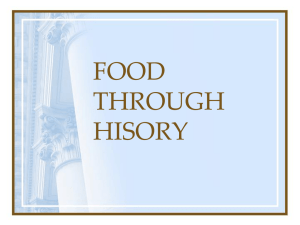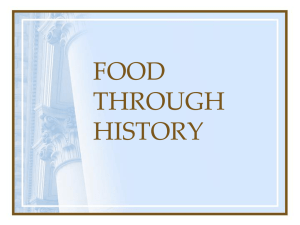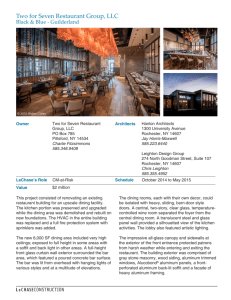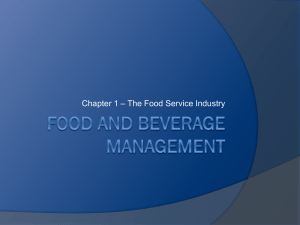Chapter One: A Look Back at the Service Industry
advertisement
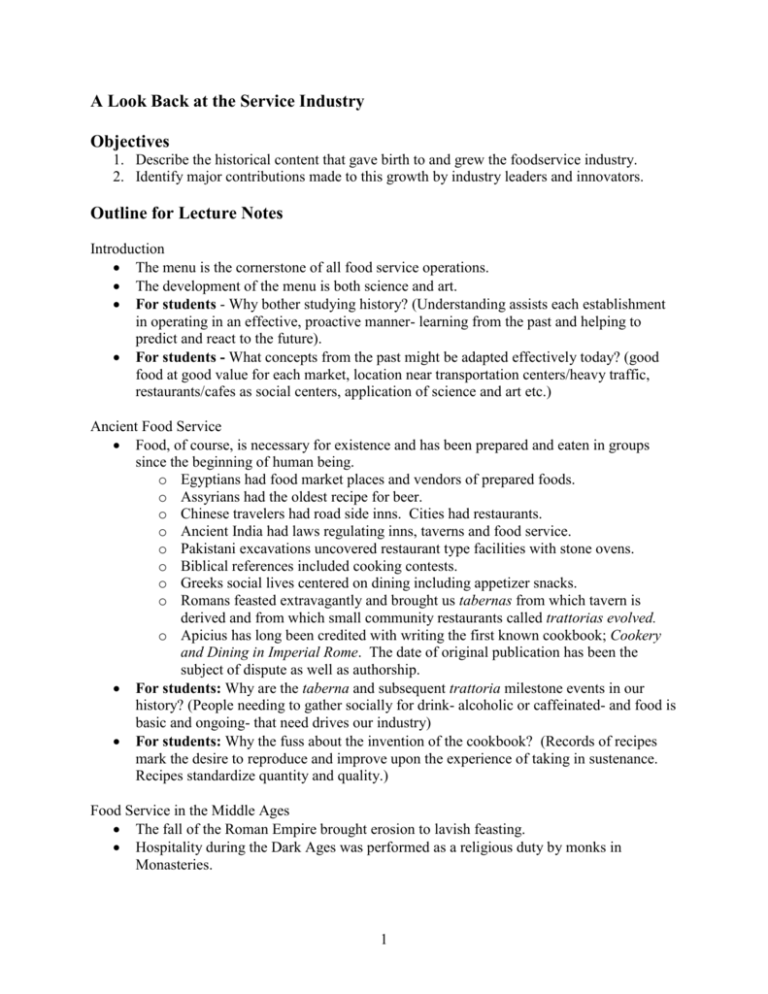
A Look Back at the Service Industry Objectives 1. Describe the historical content that gave birth to and grew the foodservice industry. 2. Identify major contributions made to this growth by industry leaders and innovators. Outline for Lecture Notes Introduction The menu is the cornerstone of all food service operations. The development of the menu is both science and art. For students - Why bother studying history? (Understanding assists each establishment in operating in an effective, proactive manner- learning from the past and helping to predict and react to the future). For students - What concepts from the past might be adapted effectively today? (good food at good value for each market, location near transportation centers/heavy traffic, restaurants/cafes as social centers, application of science and art etc.) Ancient Food Service Food, of course, is necessary for existence and has been prepared and eaten in groups since the beginning of human being. o Egyptians had food market places and vendors of prepared foods. o Assyrians had the oldest recipe for beer. o Chinese travelers had road side inns. Cities had restaurants. o Ancient India had laws regulating inns, taverns and food service. o Pakistani excavations uncovered restaurant type facilities with stone ovens. o Biblical references included cooking contests. o Greeks social lives centered on dining including appetizer snacks. o Romans feasted extravagantly and brought us tabernas from which tavern is derived and from which small community restaurants called trattorias evolved. o Apicius has long been credited with writing the first known cookbook; Cookery and Dining in Imperial Rome. The date of original publication has been the subject of dispute as well as authorship. For students: Why are the taberna and subsequent trattoria milestone events in our history? (People needing to gather socially for drink- alcoholic or caffeinated- and food is basic and ongoing- that need drives our industry) For students: Why the fuss about the invention of the cookbook? (Records of recipes mark the desire to reproduce and improve upon the experience of taking in sustenance. Recipes standardize quantity and quality.) Food Service in the Middle Ages The fall of the Roman Empire brought erosion to lavish feasting. Hospitality during the Dark Ages was performed as a religious duty by monks in Monasteries. 1 o They advanced baking, the concoction of alcoholic beverages and cooking in general. o Recipes for food and liqueurs were developed. Food was eaten from wooden trenchers using a dagger and bread as utensils. The French refined eating and a clear pattern of courses emerged with lighter foods served at the start of the meal and heavier at the end with dessert following. Henry VIIIs English court served elaborate foods with less of a course structure than the French. Guilds organized food service professionals. o Chaine de Rotissieres was charted in 12th century Paris. o They had a monopoly on the production of their specialties o They developed into the classical kitchen organization and codified standards and traditions. o The tall chef’s hat, the toque, became a symbol of the apprentice chef. For students: Why is the legacy of the guilds important? (They formed the basis of professionalism for chefs- striving for quality, pride, kitchen organization, standards, uniforms) Early Renaissance-The Development of Haute Cuisine French Cuisine In 1533 Henry II of France married Catherine de Medici of Florence, Italy. She brought master cooks who introduced many great dishes credited to France. She taught the court to eat with utensils. These were then carried with the diner when dining away from home. French courts continued and expanded on the ascendancy of haute cuisine. Sauces were named after nobility hosts. Mistresses of Louis XV were excellent cooks. Menus were elaborate with 20 or more dishes served in three courses though simplification won out in time. End of French revolution did not end love of dining. Servants now cooked in restaurants instead of homes. Gourmet writers of this period included BrillatSavarin (The Physiology of Taste), Dumas pere (The Grand Dictionaire de Cuisine) and Grimrod de la Reyniere, editor of the world’s first gourmet magazine. For students: What is the difference between eating and dining? (Eating implies taking in sustenance for survival purposes, dining refers to the joy of fine food and drink with perhaps, good company) For students: What does this have to do with the Renaissance? (This was the time period where the elements of fine dining were set in motion- quality food, eaten with utensils as a social activity- of course this was before cable televisionmaybe why the Slow Food Movement is gaining momentum) The Coming of the Restaurant Common folk ate from crude inns and taverns away from home o Places to dine out that were not private homes did not exist. o Prisons and hospitals served only the most basic minimum fare. 2 In 1600 the first coffeehouses (cafes) appeared and spread rapidly. They served mostly coffee, cocoa, wine and not much food. They were the forerunner of the modern restaurant. In 1760 Boulanger opened a place that served soups that were believed to restore health. o These soups were called restaurers and he called his establishment a restorante, now restaurant. o Guilds opposed Boulanger’s infringement and sued. o Boulanger won the right to operate and expanded his menu. o Coffeehouses followed the example and became restaurants. For students: Food had been served for a price for centuries before Boulangerwhy is he credited with being the father of the first restaurant? (His establishment introduced the word restaurant and he broke away from the guilds so that the ownership and operation of a restaurant became available to all- as it continues to be today) For students: How did the coffeehouse become the forerunner to the café, which serves food? (People were already gathered to drink beverages- selling them food also was a natural evolution- Consider what can be found on modern coffeehouse menus- breads, fresh juices, sandwiches, soups and salads as well as pastries and ice cream are often featured) Other National Cuisines England had worthy tables with food and nobility arriving to its seaports. o Represented were Spain and Portugal. o Sponge cake, Spanish hams and bacon, sherry and port incorporated into the British diet. Russia developed a fine and original cuisine o French chefs were imported to royal kitchens to work with local products. o Gatherings with vodka featured appetizers brought on platters held high. o Russian dishes include stroganoff, caviar, borscht and vodka. Italy’s distinctive cuisine is dominated by pastas though regional dishes based on what was produced locally distinguish various aspects of Italian cuisine. For students: What ethnic cuisines are popular in food service today? (Italian, Mexican, Chinese top the list with fine dining often based on French- though fusion is popular with such combinations as French Thai, Italian Mediterranean etc. may appear based on the ethnic makeup and history of a city or town) The Industrial Revolution Economic and societal changes at the end of the 18th century brought changes to commerce. o The emerging middle class demanded a high food standard served in clubs. o Lower middle class also dined out as it became affordable. For students: What significance did these events have on the future of our industry? (Pleasurable eating out experiences became available to anyone, not just royalty/nobilityit increased the market and range of needs to be filled and thus opportunity) 3 The Advancement of Science Science defined by philosophy gave way to the inductive method, advancing technology and the standard of living including food processing. Appert discovered canning, allowing food to be preserved and stored. This enlarged the year round food supply and appeared to end mass starvation. For students: Wouldn’t the ability to store food mean that people have less need to eat out? (Perhaps, but it greatly expands the ability to offer more and the mobility of the population. Restaurants have the ability to store food and serve it more safely) The Golden Age of Cuisine Careme Golden Age of Cuisine began around 1800 with Careme and ended with Escoffier, both remarkably talented chefs. o Careme was apprenticed to a restaurant owner and originally trained as a pastry chef. o He branched out and left behind his early architectural ambitions. o Careme developed the progression of courses and sequencing of accompanying wines. o He perfected consommé, sauces and highly decorated foods such as ice carvings. o He trained many famous chefs and wrote of his ideas of food, leaving a legacy that has influenced culinarians throughout history. Escoffier and Ritz Escoffier was an innovator of fine foods like Careme. He perfected the classical organization of kitchen workers defining the responsibility of each and decorum of all. o He introduced the aboyeur, who announced servers’ orders to kitchen workers. o He wrote articles and books and invented dishes though the sound uses of scientifically based quantity food production techniques. o Escoffier simplified the menu from the number of food served at each course, following Careme’s lead on the progression of courses in a formal meal from light to heavy. o He teamed up with hotelier Cesar Ritz to operate many of Europe’s finest hotels raising the level of dining and staying away from home to luxurious peaks. Food Service in the United States The Early Years Institutional Feeding Orphanages, hospitals and prisons used fireplaces or beds of coals. o Ground cooking involved cooking in an oven in a hole with food cooked in stored heat. o Universities had family style dining or table service in rooms called commons. 4 Some schools had private apartment style kitchens where a cook-slave prepared food. Hotels Appear 1818-1850 saw enormous growth in numbers of hotels to meet demand in cities such as New York and Chicago. o Famous chefs were hired to provide food. o Examples include the Astor House, Palmer House, Brown Place, and the Butler. o Western hotels flourished with newly rich from the Gold Rush to California Railroads built after the Civil War brought small hotels near railway stations and included nearby restaurants. For students: Location, location, location is an old adage for success in our industry- how does it apply to this era? (Food service flourished where there was need and high traffic) Dining Trends Lorenzo Delmonico of New York reflected the elegance and luxury of hotels in his Delmonico’s restaurants, one of the first restaurant “chains”. Workers left home to toil in factories and offices. o Coffee shops and restaurants provided modest lunch at prices suited to these employees. o Nickelodeon automatic food dispensers were developed by Horn and Hardart. o Mobile food units and facility kitchen and dining rooms were also used for employee meals. Disposable income rose as did mobility spurred by the invention of the automobile. Electricity powered refrigerators, freezers, mixers and dishwashers, preserving food and labor resources. For students: How do cars and power help our industry evolve? (Increases mobility of customers, increasing available locations and demand and helps us store food, and raise productivity- keeping prices within reach of customers) Postwar Expansion Post WWII, foodservice grew rapidly due to the expansion of industrial feeding. 1946’s National School Lunch Act started educational food service on a massive scale. Dieticians were sought out for institutional as well as commercial enterprises. Cornell University introduced the first hotel school in the US which added restaurant, institutional and tourism curriculum. Statler led the way in development of vast hotel chains. People ate out to fulfill social and psychological desires. 5 For students: Do dieticians have a role to play in food service today? (Institutional clients must have nutritious offerings and commercial customers are demanding food that is not only safe from a sanitary perspective but safe in terms of health) For students: It is not required to have an education in order to operate food service establishments. Why get one, particularly back then? (Professionalism in complex business that is increasingly competitive) Quick Service and Corporate Concepts Fast Food or Quick Service served food that could be prepared and eaten quickly, starting with the White Castle hamburger units of the 1930s. Chicken was also a popular entrée item. Corporate Concepts or Chains began in conjunction with QSRs. Assembly production of these lower priced, lower margin items was made profitable through volume sales. Today, QSR chains make up a very significant portion of restaurants and an even higher proportion of sales nationally. Corporations gained on the predominance of independently owned entrepreneurships. Take out and curbside service is important and is expected to grow. o Dual incomes, busy lives and convenience motivate consumers. o This segment includes QSR drive-throughs, grocery delis, and cafeterias. o Curbside service is offered by casual and fine dining establishments in regular or family size portions. o Close to half of the food sold by food services is considered take-out. o Dave Thomas was a pioneer of “adult” quick service with his Wendy’s concept including a salad and baked potato bar. He created the modern pick-up window. Rich Melman’s Lettuce Entertain You Enterprises is renowned for remarkable success. o Over thirty separate menu concepts are currently operating. o Listening to people and giving them what they want before they know they want it is key o People are important- both customers and employees o Menus from LEYE are featured as illustrations throughout the text and Student Manual For students: Have any student(s) worked for a chain or corporate conceptdescribe experience and discuss advantages and disadvantages (Proven formula, less room for individual creativity with most chains) For students: Do any students have ideas for a concept they would like to franchise? (Franchise will be discussed more later in the text- this is introductory question- expect a variety of answers) Continual Growth The foodservice industry has grown tremendously with no signs of slowing. It is predicted people will soon be eating more than half of meals outside the home. 6
